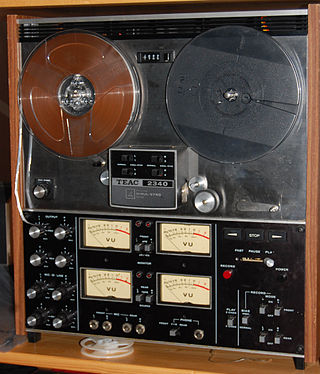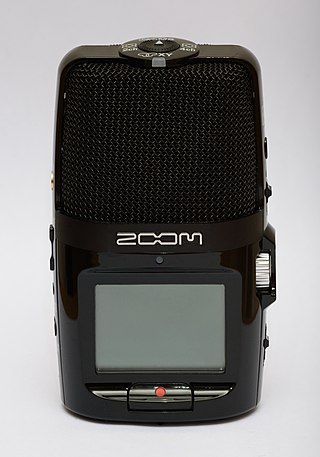
MiniDisc (MD) is an erasable magneto-optical disc-based data storage format offering a capacity of 60, 74, and later, 80 minutes of digitized audio.

Digital audio is a representation of sound recorded in, or converted into, digital form. In digital audio, the sound wave of the audio signal is typically encoded as numerical samples in a continuous sequence. For example, in CD audio, samples are taken 44,100 times per second, each with 16-bit sample depth. Digital audio is also the name for the entire technology of sound recording and reproduction using audio signals that have been encoded in digital form. Following significant advances in digital audio technology during the 1970s and 1980s, it gradually replaced analog audio technology in many areas of audio engineering, record production and telecommunications in the 1990s and 2000s.

Multitrack recording (MTR), also known as multitracking, is a method of sound recording developed in 1955 that allows for the separate recording of multiple sound sources or of sound sources recorded at different times to create a cohesive whole. Multitracking became possible in the mid-1950s when the idea of simultaneously recording different audio channels to separate discrete "tracks" on the same reel-to-reel tape was developed. A "track" was simply a different channel recorded to its own discrete area on the tape whereby their relative sequence of recorded events would be preserved, and playback would be simultaneous or synchronized.
Ping-pong recording is a method of sound recording. It involves combining multiple track stems into one, allowing more room for overdubbing when using tape recorders with a limited set of tracks. It is also used to simplify mixdowns.
TEAC Corporation is a Japanese electronics manufacturer. TEAC was created by the merger of the Tokyo Television Acoustic Company, founded in 1953, and the Tokyo Electro-Acoustic Company, founded in 1956.

The TASCAM Portastudio was the first four-track recorder based on a standard compact audio cassette tape. The term portastudio is exclusive to TASCAM, though it is generally used to describe all self-contained cassette-based multitrack recorders dedicated to music production. The Portastudio, and particularly its first iteration, the Teac 144, is credited with launching the home-recording wave, which allowed musicians to cheaply record and produce music at home, and is cited as one of the most significant innovations in music production technology.
Home recording is the practice of recording sound in a private home instead of a professional recording studio. A studio set up for home recording is called a home studio or project studio. Home recording is widely practiced by voice actors, narrators, singers, musicians, podcast hosts, and documentary makers at all levels of success. The cost of professional audio equipment has dropped steadily as technology advances during the 21st century, while information about recording techniques has become easily available online. These trends have resulted in an increase in the popularity of home recording and a shift in the recording industry toward recording in the home studio. The COVID-19 pandemic and COVID-19 lockdowns resulted in a dramatic global increase in the number of remote workers in 2020, which is anticipated by experts to remain a permanent shift in the field of sound recording when the pandemic ends.
Soundstream Inc. was the first United States audiophile digital audio recording company, providing commercial services for recording and computer-based editing.
Harrison Audio Consoles is an international company based in Nashville, Tennessee that manufactures high-end mixing consoles, Digital Audio Workstations (DAW), audio plugins, and other audio technologies for the post-production, video production, broadcast, sound reinforcement and music recording industries. The company is renowned as an industry innovation for its "in-line" mixing console design that has subsequently become the standard for nearly every large-format music console. Over 1,500 Harrison consoles have been installed worldwide, presenting a significant percentage of the overall world market share for high-end audio consoles. The company founder, Dave Harrison, was inducted as a Fellow in the Audio Engineering Society for this technical contribution of the recording industry and in particular the first 32-bus "in-line" console.
Foster Denki KK is an electronics company that manufactures loudspeakers and audio equipment for other companies or sells them under the trade name Fostex. It is traded on the Tokyo Stock Exchange.
Dokorder was a brand of tape recorder from Japanese electronics company Denki Onkyo, located in Ōta, Tokyo that included a four-reel transport system called "Dub-A-Tape" capable of feeding two different tapes through the same tape head assembly and, in the process, recording a duplicate of a tape. (The master and blank tapes passed through the same capstan, but through different tape head areas, yielding a Y-shaped tape path reflected in the slots built into the head assembly. Denki Onkyo also supplied a consumer and semi-pro line of reel to reel recorders that competed with Tascam/Teac and Sony but ultimately its products were found to be less durable than the competition.

Multitrack recording of sound is the process in which sound and other electro-acoustic signals are captured on a recording medium such as magnetic tape, which is divided into two or more audio tracks that run parallel with each other. Because they are carried on the same medium, the tracks stay in perfect synchronization, while allowing multiple sound sources to be recorded at different times.
Unique Recording Studios was a five-room recording studio operating near Times Square in New York City from 1978 until 2004. Founders and co-owners Bobby Nathan and Joanne Georgio-Nathan installed the first Otari 24-track tape deck in New York. The studio was known for its extensive collection of synthesizers, which attracted Steve Winwood, who jammed for many hours in the process of creating his multi-Grammy winning album Back in the High Life (1986) at Unique.

In sound recording and reproduction, audio mixing is the process of optimizing and combining multitrack recordings into a final mono, stereo or surround sound product. In the process of combining the separate tracks, their relative levels are adjusted and balanced and various processes such as equalization and compression are commonly applied to individual tracks, groups of tracks, and the overall mix. In stereo and surround sound mixing, the placement of the tracks within the stereo field are adjusted and balanced. Audio mixing techniques and approaches vary widely and have a significant influence on the final product.
The DA-88 was a digital multitrack recording device introduced by the TASCAM division of the TEAC Corporation in 1993. This modular, digital multitrack device uses tape as the recording medium and could record up to eight tracks simultaneously. It also allowed multiple DA-88 devices to be combined to record 16 or more tracks. The first models in the series recorded at 16-bit resolution. TASCAM later introduced the DA-98HR and DA-78HR, which recorded at 24-bit resolution and sample rates up to 48 kHz and 192 kHz. Audio data was stored in the DTRS format on Hi8 video cassettes, allowing up to 108 minutes of continuous recording on a single tape.
Frank Morrone is an independent re-recording mixer who has worked extensively in both film and television. His award winning work includes Emmy Awards for the ABC hit LOST and the mini-series The Kennedys as well as a best sound Satellite Award for Tim Burton's Sleepy Hollow.

DPA Microphones is a Danish manufacturer of condenser microphones and microphone solutions for the professional markets, owned by the Italian private equity fund, Palladio Holding S.p.A. The current CEO is Kalle Hvidt Nielsen. The company was founded in 1992 by two former employees from Brüel & Kjær - Morten Støve and Ole Brøsted Sørensen. Brüel & Kjaer had decided to close their Pro Audio department and Morten and Ole made a contract with B&K to take over sales, service and development. DPA was at that time solely supplying high end studio microphones for recording and broadcast use. In 1995 they teamed up with Dan Ingemann Jensen and Jens Jørn Stokholm from DanaBallerina and co-developed the later famous DPA 4060 and 4061 miniature condenser microphone, which quickly became the preferred microphone in the theatre world on Broadway in New York and the West End in London. The company received the prestigious King Frederik IX award at a ceremony in Fredensborg Castle.

Quadraphonic open reel tape or Q4 was the first consumer format for quadraphonic sound recording and playback. Pre-recorded tapes in this format were introduced in the United States by the Vanguard Recording Society in June 1969. Specialized machines to play these tapes were introduced by electronics manufacturers such as TEAC Corporation at about the same time.

The Zoom H2n is a portable digital sound recording device manufactured by Zoom. It is the successor of the Zoom H2 recorder. The Zoom H2n has four microphone capsules built inside it. Musical applications for the H2n include the ability to use the device as a stereo or multi-track (four-channel) recorder; the device also includes built-in editor for some minor editing works with in the device.

An audio interface is a piece of computer hardware that allows the input and output of audio signals to and from a host computer or recording device.














